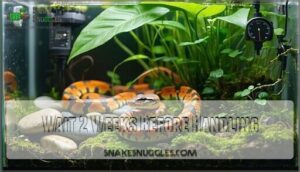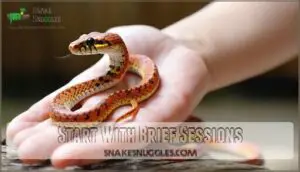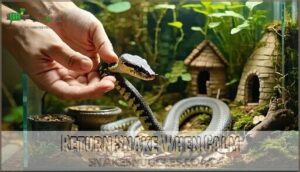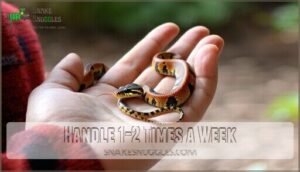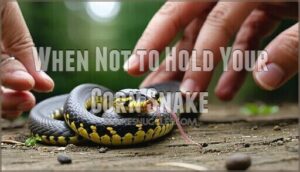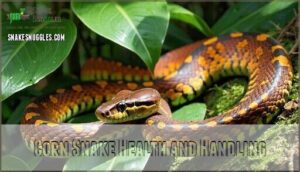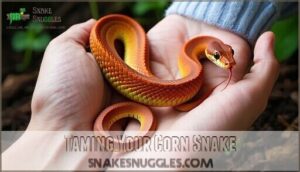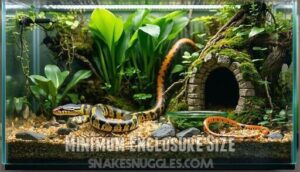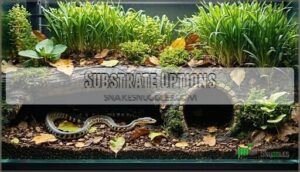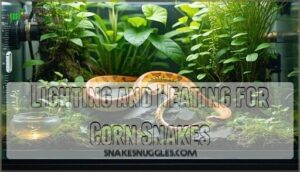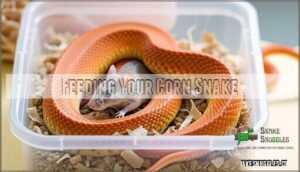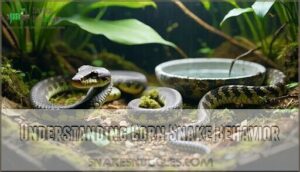This site is supported by our readers. We may earn a commission, at no cost to you, if you purchase through links.
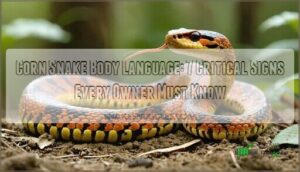
When they rapidly flick their tongue, they’re gathering information about their surroundings.
A motionless snake might be comfortable or stressed, depending on context.
If your snake coils its neck into an S-shape, it’s feeling defensive and ready to strike.
Hissing serves as their warning system, while tail shaking mimics a rattlesnake’s threat display.
These behaviors aren’t random—they’re your snake’s way of communicating their comfort level.
Understanding these signals helps you know when to give space or when handling is safe, and there are specific timing rules that make all the difference.
These rules are crucial for maintaining a safe and healthy relationship with your pet snake, and recognizing the warning system is key.
Table Of Contents
- Key Takeaways
- Corn Snake Body Language
- Top 6 Corn Snake Care Essentials
- Handling Your Corn Snake
- When Not to Hold Your Corn Snake
- Corn Snake Health and Handling
- Taming Your Corn Snake
- Corn Snake Enclosure Requirements
- Lighting and Heating for Corn Snakes
- Feeding Your Corn Snake
- Understanding Corn Snake Behavior
- Frequently Asked Questions (FAQs)
- How to tell if your corn snake likes you?
- How to tell if a corn snake is stressed?
- What does it mean when a corn snake stares at you?
- How to tell if a corn snake is ill?
- How do I know if my corn snake is happy?
- How to tell if a snake is comfortable with you?
- How do you know if a corn snake is angry?
- How do corn snakes communicate?
- How do you know if a corn snake is awake?
- What do corn snakes eat?
- Conclusion
Key Takeaways
- You can read your snake’s mood through tongue flicking and body position – rapid tongue flicks show heightened awareness, while slow movements indicate calm exploration, and an S-shaped neck coil signals defensive behavior ready to strike.
- Hissing and tail shaking are clear warning signs – when your corn snake hisses or vibrates its tail like a rattlesnake, it’s telling you to back away immediately because it feels threatened or stressed.
- You shouldn’t handle your snake during specific times – avoid handling within 48 hours of feeding, during shedding when eyes turn milky blue, or when your snake displays defensive behaviors like coiling or musking.
- Proper environment and handling build trust – give your new snake 2 weeks to settle, start with brief 5-10 minute sessions once weekly, and maintain proper temperature gradients and hiding spots to reduce stress-related defensive behaviors.
Corn Snake Body Language
You can understand your corn snake’s mood and needs by watching its body language signals.
These physical cues tell you when your snake feels safe, stressed, or ready to defend itself.
Tongue Flicking and What It Means
When your corn snake flicks its tongue, it’s gathering essential sensory input about its environment.
This scent detection system helps with prey location and environmental exploration.
Fast, frequent flicks signal heightened awareness or potential threats.
Slow, relaxed tongue movements indicate calm exploration mode.
Understanding these communication signals helps you read your snake’s mood and respond appropriately to their reptile communication needs.
No Movement: Asleep or Stressed?
When your snake shows no movement, you’re witnessing either natural resting posture or stress signs.
Snake sleep appears as complete stillness with no tongue flicking. Snake stress manifests as frozen behavior even when gently disturbed.
Check Environmental Factors like temperature and hiding spots. Handling Impact increases stress, so minimize interaction.
These Observation Tips help distinguish between normal snake behavior and concerning Stress Indicators.
Coiled Neck: Threat or Defense?
When your corn snake coils its neck, it’s communicating defensive behavior rather than true aggression.
This coiled neck posture serves as a warning signal before potential striking. Understanding these coiled neck signals helps you interpret your snake’s comfort level.
- Neck Coiling Triggers: Sudden movements or feeling cornered
- Defensive vs. Threat: Bluffing behavior, not actual aggression
- Interpreting Coils: Tightly wound neck indicates stress
- Response Strategy: Give space until snake relaxes
Hissing: Warning or Fear?
When your corn snake hisses, it’s communicating fear or issuing a warning.
When your corn snake hisses, back away immediately – it’s telling you exactly how it feels.
This defensive hissing serves as a last resort before striking.
Don’t handle during these episodes – give your snake space instead.
| Hissing Triggers | Snake Behavior | Your Response |
|---|---|---|
| Sudden movements | Snake aggression increases | Move slowly, retreat |
| Loud noises | Defensive behavior activates | Reduce sound levels |
| Unfamiliar scents | Hissing frequency rises | Wash hands thoroughly |
| Overcrowding | Stress-induced hissing | Provide hiding spots |
| Poor hissing and health | Illness-related aggression | Consult veterinarian |
Hissing and handling don’t mix – wait until your snake calms down.
Tail Shaking: Defense Mechanism
When your corn snake’s tail starts vibrating, it’s sending a clear defensive signal – much like a rattlesnake’s warning without the rattle.
This tail movement serves as a predator deterrent, communicating "back off" in snake language.
Corn snakes often exhibit this tail rattling behavior when feeling threatened.
Your snake uses tail shaking when it feels:
- Threatened by sudden movements
- Stressed from handling attempts
- Startled by unexpected sounds, which can be a clear sign of stress or feeling threatened.
Top 6 Corn Snake Care Essentials
You’ll need specific equipment to create the right environment for your corn snake’s health and comfort.
These six essential products provide proper lighting, heating, and substrate that support natural behaviors and prevent stress-related body language signals, which is crucial for the snake’s overall comfort.
1. Zoo Med Deep Dome Lamp Large
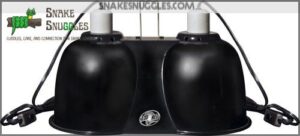
You’ve mastered reading corn snake body language, but proper lighting makes observation easier.
The Zoo Med Deep Dome Lamp Large creates the perfect basking area for your snake enclosure. This dual fixture handles up to 160 watts per socket, giving you flexibility with bulb wattage guide options.
The polished aluminum dome maximizes heat lamp safety while providing ideal lamp placement. With proper reptile lighting spectrum, you’ll spot handling cues and behavioral changes more effectively in your reptile’s habitat.
Remember to provide consistent lighting schedules for circadian rhythms.
2. Zoo Med Reptisoil Blend
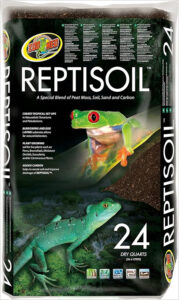
Perfect lighting sets the stage, but your corn snake needs proper ground cover too.
Zoo Med’s Reptisoil Blend delivers the ideal substrate composition for natural snake behavior. This tropical mixture supports healthy digging instincts while maintaining ideal humidity levels.
The carbon-enriched formula provides excellent drainage yet retains moisture perfectly. Simply add water to activate this naturalistic bedding.
Your snake’s posture and signals will show contentment as they burrow and explore. Reptisoil alternatives exist, but this blend matches corn snake body language needs best.
3. Zilla Pet Reptile Terrarium Substrate
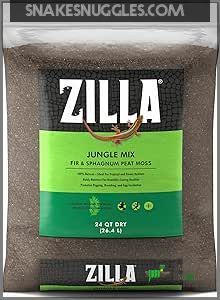
Quality substrate composition matters for your corn snake’s wellbeing and proper humidity control. Zilla’s Pet Reptile Terrarium Substrate combines aged fir bark with sphagnum peat moss, creating an ideal naturalistic setup that supports healthy snake behavior.
The organic blend maintains ideal moisture levels while allowing natural burrowing instincts. For proper substrate depth, spread 2-3 inches throughout the enclosure. Cleaning procedures stay simple – spot-clean waste daily and replace monthly.
This substrate helps you read corn snake body language more easily, as relaxed snake posture and natural snake signals indicate your pet feels secure in their environment. Your snake’s reptile behavior will thank you.
4. Philips 90W Halogen Flood Light Bulb
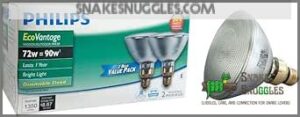
This bulb’s heat output creates the perfect basking temperature your corn snake craves.
Halogen bulb benefits include natural light that mimics sunlight, helping you read your snake’s body language and posture clearly.
With proper lighting placement over the warm side, you’ll maintain that essential temperature gradient.
Wattage considerations matter – 90W provides consistent warmth without overheating.
The bulb lifespan exceeds standard incandescent options, making it cost-effective.
Watch your snake’s behavior and signals improve as it enjoys this natural communication with its environment.
Best For: Experienced corn snake keepers looking to create a basking area with a warm, natural light.
5. Flukers Ceramic Heat Emitter
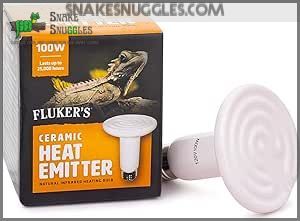
The Fluker’s Ceramic Heat Emitter provides consistent nighttime warmth without disrupting your corn snake’s natural sleep cycle.
This 100W ceramic element offers excellent Heat Emitter Benefits through infrared radiation, creating the perfect basking area temperature.
Its ceramic construction guarantees impressive Longevity Factors compared to traditional bulbs.
The Safety Features include non-light emission, making it ideal for maintaining proper snake enclosure temperatures while supporting healthy corn snake behavior patterns with infrared radiation.
6. Flukers Heavy Duty Clamp Lamp
Security matters when positioning heat sources in your corn snake enclosure.
Flukers Heavy Duty Clamp Lamp delivers reliable performance with its 8.5-inch painted aluminum clamp and ceramic socket design. This UL/CUL approved fixture guarantees your heating setup won’t shift or fall, protecting your snake from accidents.
Key features include:
- Secure positioning prevents lamp placement issues
- Dimmer switch controls heat output precisely
- Ceramic socket handles high-wattage bulbs safely
- Heavy-duty construction guarantees long-term lamp safety
Best For: Corn snakes requiring stable heating solutions.
Handling Your Corn Snake
You can’t just grab your corn snake whenever you want to hold it.
Proper handling requires you to read your snake’s body language first, then follow specific timing and techniques to keep both you and your snake safe.
Wait 2 Weeks Before Handling
When you bring your corn snake home, resist the urge to handle it immediately.
Your snake needs an Initial Adjustment Period of two weeks to adapt to its new environment.
Handling After Settling prevents defensive reactions like hissing or biting.
This Building Trust phase reduces stress and creates a foundation for positive interactions.
Patience during this period guarantees your corn snake feels secure before human contact begins.
Start With Brief Sessions
Those first handling sessions should feel like a gentle introduction, not a marathon.
Keep your corn snake handling to just 5-10 minutes initially.
This session length helps with building trust without overwhelming your pet.
Start with handling frequency of once weekly, watching for calm snake behavior.
Short sessions create positive reinforcement, making future snake handling easier as your corn snake learns you’re safe.
Return Snake When Calm
Your snake’s relaxed body posture signals it’s time to end the session.
When you notice minimal movement and loose positioning, gently place your snake back home.
This positive reinforcement teaches that handling frequency stays predictable and safe.
Building trust happens through consistent short session duration and reading snake body language.
A calm return creates calm handling benefit for future interactions.
Handle 1-2 Times a Week
Regular snake handling 1-2 times weekly creates the perfect balance for building trust with your corn snake. This handling frequency prevents stress while maintaining familiarity with human contact.
Your handling sessions offer these key benefits:
- Monitor your snake’s health and temperament changes
- Reinforce calm behavior through positive experiences
- Prevent defensive responses from lack of interaction
- Strengthen the human-snake bond over time
- Identify potential health issues before they worsen
Consistency in safe handling practices makes all the difference.
When Not to Hold Your Corn Snake
You shouldn’t handle your corn snake when it shows defensive body language or during specific physical states.
These situations can stress your snake and may result in defensive bites or regurgitation.
Within 48 Hours of Feeding
Patience becomes your best friend after feeding time. Your corn snake needs 48 hours to complete its digestive process without interference.
Post-feeding handling creates serious regurgitation risk and digestive discomfort. Respect your snake’s feeding schedule to avoid triggering a defensive feeding response that could harm both your snake’s health and your trust-building progress.
| Time After Feeding | Snake’s State | Handling Recommendation |
|---|---|---|
| 0-24 hours | Active digestion | Absolutely no handling |
| 24-48 hours | Completing digestion | Still avoid handling |
| 48+ hours | Ready for interaction | Safe to handle again |
During Shedding
Your snake’s shedding process requires patience and hands-off care. During this vulnerable time, their eye color changes to a milky bluish color, and skin appearance becomes dull.
Handling during shedding can damage delicate new skin underneath. The snake shedding cycle affects their vision and stress levels substantially.
- Monitor humidity needs closely (50-60%) for proper skin shedding
- Provide rough surfaces like branches for rubbing assistance
- Expect decreased appetite during shedding behavior changes
- Watch for the milky eye phase indicating snake skin shedding begins
- Allow complete privacy until fresh skin emerges naturally
If Snake is Defensive
When your corn snake displays defensive behavior, step back immediately.
Watch for warning signs like S-shape posture, hissing sounds, and tail shaking – these indicate stress or fear.
Defensive handling attempts often trigger snake strikes and potential biting. Give your snake space until it relaxes.
Patient bite prevention starts with reading snake body language correctly and respecting boundaries.
If Snake is in Blue
Milky-blue eyes signal your corn snake’s shedding process has begun. During this vulnerable time, your snake’s vision becomes cloudy, making it defensive and stressed.
The eye appearance changes dramatically, indicating you should avoid handling during this period. Younger corn snakes typically undergo <strong>more frequent shedding</strong>.
Snake mood shifts to more aggressive as humidity changes affect comfort. Skip feeding during blue phase to prevent health issues until shedding completes.
If Snake is Musking
When your snake starts musking, back away immediately. This pungent defensive behavior means your corn snake feels genuinely threatened and will release a foul-smelling secretion from its cloaca. The unmistakable odor serves as nature’s "stay back" warning.
- Musk Definition: Foul-smelling liquid released from the cloaca during stress
- Musk Causes: Fear, handling pressure, or perceived threats trigger this response
- Musk Smell: Extremely unpleasant, lingering odor that’s hard to remove
- Musk Removal: Wash hands thoroughly with dish soap and white vinegar
- Musk Prevention: Approach calmly and watch for snake body language cues
Corn Snake Health and Handling
You can tell if your corn snake is healthy by watching for clear eyes, active movement, and regular eating habits.
Understanding these health signs helps you handle your snake safely and know when to contact a veterinarian.
Common Health Problems
Several health problems can affect your corn snake’s well-being.
Respiratory issues cause wheezing and mouth breathing. Mouth rot creates swollen gums and oral lesions.
Scale rot appears as discolored, soft belly scales. Parasite infections lead to snake weight loss and appetite changes.
Dehydration causes wrinkled skin and lethargy. Watch for snake regurgitation and unusual behavioral changes indicating potential signs of health problems.
Signs of a Healthy Snake
Identifying wellness indicators helps you gauge your corn snake’s overall condition.
A thriving snake displays consistent patterns that signal good health.
Key signs include:
- Clear Eyes – Bright, alert appearance without cloudiness or discharge
- Active Movement – Regular exploration and normal behavior throughout their habitat
- Good Appetite – Consistent feeding response with proper weight maintenance and no abnormalities
Signs of an Unhealthy Snake
Watch for Weight Loss and Appetite Loss – these are red flags your snake’s struggling.
If you notice Body Rubbing against tank objects or Unusual Coiling patterns, something’s wrong.
Eye Problems like cloudiness signal trouble ahead.
Signs of distress include labored breathing and crusty scales.
These stress indicators demand immediate veterinary attention to prevent serious health problems.
Taming Your Corn Snake
Understanding your corn snake’s temperament sets the foundation for successful taming. Building trust with your new pet requires patience and consistent positive reinforcement techniques.
Allow your snake two weeks to settle into its new environment before attempting any handling sessions. This adjustment period helps reduce stress and establishes a calm baseline for future interactions.
Start with brief five-minute session duration periods, gradually extending them as your snake becomes comfortable. Handle your pet 1-2 times weekly – this handling frequency prevents overwhelming while maintaining familiarity.
Key taming principles include:
- Support the snake’s body completely during handling to provide security
- End sessions immediately if you notice defensive corn snake body language like hissing
- Return your snake when calm to reinforce positive associations
Avoiding stress signals guarantees successful taming snakes outcomes and builds lasting trust between you and your corn snake. When handling, it’s vital to understand handling techniques for snakes to avoid stress.
Corn Snake Enclosure Requirements
Your corn snake’s behavior directly connects to its living space, and you’ll notice stress signals when the enclosure doesn’t meet basic requirements.
You need a minimum 40-gallon tank with proper substrate, hiding spots, and temperature zones to keep your snake healthy and reduce defensive behaviors like hissing or tail shaking.
Minimum Enclosure Size
Your corn snake needs adequate space to thrive and display natural corn snake body language.
The minimum enclosure size is 4′ x 2′ x 2′ for proper enclosure setup.
Enclosure dimensions directly impact snake behavior and well-being. Secure enclosure design prevents escapes while allowing room for movement.
Proper enclosure design with sufficient space reduces stress and promotes healthy activity patterns in your pet.
Substrate Options
After setting up your enclosure size, choosing the right snake substrate becomes your next priority. Your corn snake needs substrate that holds moisture without becoming soggy. Substrate depth should reach 2-3 inches for proper burrowing behavior.
Consider these substrate options for your pet snake:
- DIY mix: Combine topsoil, reptile soil, and play sand for cost-effective reptile care
- Pre-packaged: Zilla Jungle Mix or Eco Earth offer convenience and consistent substrate humidity
- Bioactive setup: Living substrate with beneficial bacteria handles waste naturally
To maintain humidity, consider options that offer superior moisture retention. Cleaning substrate involves spot-cleaning waste weekly and full replacements monthly, keeping substrate cost manageable while maintaining your corn snake’s health.
Environmental Enrichment
Creating a stimulating environment helps your corn snake express natural behaviors and reduces stress-related body language cues.
Hiding spots provide security, while climbing structures encourage exploration. Substrate choices enable burrowing instincts.
Enrichment toys and varied textures promote mental stimulation. A proper temperature gradient supports thermoregulation.
Environmental enrichment directly impacts snake behavior – well-designed enclosures produce calmer, healthier reptiles with positive body language.
Owners can find various options for snake habitat upgrades to enhance their pet’s well-being.
Lighting and Heating for Corn Snakes
You’ll need proper lighting and heating equipment to create the right temperature zones your corn snake needs for healthy body language and behavior.
Your snake requires a basking area between 88-90°F and a cooler side around 70-75°F, plus UVB lighting to support normal metabolism and reduce stress-related defensive postures.
UVB Lamp Recommendation
Once you’ve got your corn snake’s enclosure set up, proper lighting becomes your next priority.
UVB benefits include healthy metabolism and strong immune function for your reptile. Choose a 35-watt metal halide UVB lamp for ideal results.
You can find a wide selection online. Position it 12-16 inches above the basking spot.
Replace bulbs every 6-12 months since bulb lifespan affects effectiveness. Brand comparison shows Zoo Med and Exo Terra lead quality rankings.
Measuring Temperature
Proper snake temperature regulation requires accurate monitoring tools.
Digital thermometers beat analog versions for precision – place probes on your snake’s cool side and basking spot.
An infrared temp gun helps you check basking area hotspots instantly.
Monitor ambient temp throughout the enclosure, not just surface readings.
Your snake’s warmth depends on reliable measurements, not guesswork.
Consider using a reliable digital option for accuracy.
Humidity Requirements
Maintaining proper humidity levels between 40-60% keeps your corn snake healthy and supports natural shedding cycles.
Your reptile’s behavior changes when humidity drops too low, affecting their comfort and well-being.
- Measuring humidity: Use a digital hygrometer placed on the cool side for accurate readings
- Humidity sources: Lightly mist substrate or add a humid hide filled with damp moss
- Shedding and humidity: Increase levels to 60-70% during pre-shed to prevent stuck skin
Feeding Your Corn Snake
Your corn snake’s feeding behavior reveals important clues about its health and comfort level.
You’ll need to understand how proper nutrition affects your snake’s body language, since hungry or stressed snakes often display defensive postures that can make handling difficult, which is related to their overall comfort.
Obligate Carnivores
Your corn snake’s dietary needs are non-negotiable – they’re obligate carnivores who must consume whole animal prey to survive.
Unlike omnivores, these snake feeding requirements can’t be met with plant matter or processed foods.
Their digestion process specifically evolved for prey items like mice and rats.
Understanding proper feeding frequency prevents nutritional deficiencies and supports their nutritional needs perfectly.
Whole Animal Prey
Throughout their lives, corn snakes require whole animal prey that matches their body width.
Pre-killed frozen mice work best for prey sourcing and prey storage safety.
Young snakes eat pinkie mice weekly, while adults consume adult mice monthly.
This feeding frequency supports natural snake behavior and snake communication patterns.
Proper prey size prevents regurgitation and maintains healthy snake body language during meals.
Calcium and Vitamin Supplements
Essential calcium supplements and vitamin supplements prevent deficiency symptoms like lethargy and poor appetite in your snake’s key organs.
Dust prey with reptile calcium powder twice weekly and multivitamin monthly following dosage guidelines.
Popular supplement brands offer targeted nutrition for peak snake health.
Proper supplement timing and health monitoring guarantee your corn snake thrives with supplement benefits supporting metabolic functions.
Understanding Corn Snake Behavior
You can identify normal corn snake behavior by watching for active movement, regular tongue flicking, and relaxed body positions.
Understanding these behaviors helps you tell the difference between a healthy snake and one showing signs of stress or illness.
Normal Snake Behavior
Understanding your pet’s routine helps you recognize healthy corn snake body language.
Your snake will spend most daylight hours sleeping, then become active at night – this flip in sleep patterns is perfectly normal.
You’ll see them exploring their enclosure, checking out warm spots for basking, and even attempting escape missions.
Normal behavior includes:
- Hiding for days after meals – they’re just digesting in peace
- Coming to investigate when you approach their home
- Seeking out their favorite basking spots during daily activities
Signs of Distress
Spotting signs of distress in your corn snake requires careful observation of behavioral changes.
Watch for appetite loss, weight loss, and excessive body rubbing against tank objects.
An S-shape posture indicates your snake feels threatened and may strike.
Snake hissing signals fear or warning, while snake agitation shows through rapid movements.
Snake skittishness, avoidance of food, and defensive striking positions all point to stress requiring immediate attention.
Recognizing these stress signals is essential for your snake’s well-being.
It is crucial to identify signs of distress and take action to prevent further stress.
Signs of Health Problems
Your snake’s health problems often show up as subtle changes before becoming serious issues.
Watch for decreased muscle tone, lethargy, and clear eyes that turn cloudy outside of shedding periods.
Key warning signs include:
- Weight Loss combined with appetite loss lasting more than two feeding cycles
- Unusual Shedding patterns with stuck shed or incomplete molts
- Respiratory Issues like mouth breathing, wheezing, or Mouth Rot symptoms
Frequently Asked Questions (FAQs)
How to tell if your corn snake likes you?
You’ll notice your corn snake relaxes when you handle it, doesn’t hiss or coil defensively, and explores calmly on your hands.
Regular tongue flicking shows curiosity rather than stress, indicating comfort with your presence.
How to tell if a corn snake is stressed?
When your scaly friend isn’t feeling their best, you’ll notice defensive behaviors like coiling tightly, hissing, tail rattling, refusing food, or forming an S-shape with their body ready to strike.
What does it mean when a corn snake stares at you?
When your corn snake stares at you, it’s likely curious and alert, using its keen vision to assess you as a potential threat or food source.
This focused attention indicates awareness rather than aggression or affection.
How to tell if a corn snake is ill?
Watch for weight loss, watch for appetite changes, watch for unusual behaviors.
You’ll spot illness through clear warning signs: avoiding food, regurgitating meals, excessive hiding, rubbing against tank objects, or forming defensive S-shapes when previously calm.
How do I know if my corn snake is happy?
You’ll see relaxed body language when your snake stretches out comfortably, flicks its tongue curiously, and moves calmly around its enclosure.
Happy snakes eat regularly, shed completely, and don’t display defensive postures like hissing or coiling tightly.
How to tell if a snake is comfortable with you?
About 85% of snake bites occur when handlers misread body language.
Your snake’s comfortable when it moves slowly, tongue flicks calmly, and doesn’t coil defensively.
Relaxed posture and steady exploration mean you’ve earned its trust.
How do you know if a corn snake is angry?
You’ll notice your snake coiling into an S-shape, hissing loudly, or shaking its tail rapidly.
These defensive signals mean it feels threatened and you should back away immediately to avoid a potential strike.
How do corn snakes communicate?
Like ancient messengers using smoke signals, your corn snake speaks through body language.
They communicate by tongue-flicking to "smell" surroundings, coiling when stressed, hissing as warnings, and positioning their bodies to show comfort or threat, which can be seen as a form of warning.
How do you know if a corn snake is awake?
You’ll notice your corn snake is awake when its tongue flicks in and out, "tasting" the air around it.
Active movement and alert positioning also signal wakefulness, while motionless snakes are typically sleeping.
What do corn snakes eat?
You’ll feed your corn snake whole prey like mice or rats.
Young snakes eat pinkie mice every 5-7 days, while adults consume adult mice every 10-14 days.
Choose frozen-thawed prey that’s appropriately sized.
Conclusion
Understanding corn snake body language works like learning a new language—each signal carries specific meaning.
You’ll recognize when your snake feels comfortable, stressed, or defensive by watching their tongue flicking, neck positioning, and tail movements.
These behavioral cues help you determine safe handling times and avoid unnecessary stress.
Remember to wait after feeding, respect shedding periods, and respond appropriately to defensive postures.
Mastering corn snake body language strengthens your bond and guarantees your pet’s wellbeing through proper interpretation of their communication signals.
- https://www.youtube.com/c/LoriTorriniAnimalBehavior
- https://www.reptifiles.com/corn-snake-care-guide/corn-snake-diseases-health/corn-snake-shedding/
- https://animals.mom.com/can-snakes-tell-people-apart-html
- https://internetreptile.com/blogs/care-sheets/corn-snake-care-sheet
- https://aminoapps.com/c/reptiles/page/blog/psa-dont-cohabitate-solitary-snake-species/QKdl_d26HXuzxvEaKgkN4egZvVmVbJr5nr

